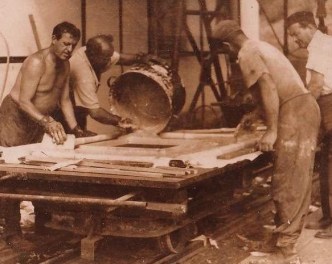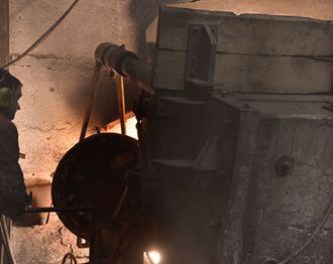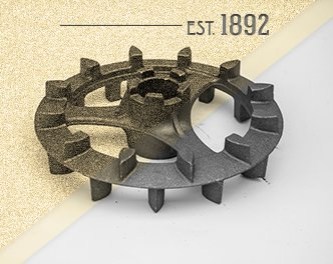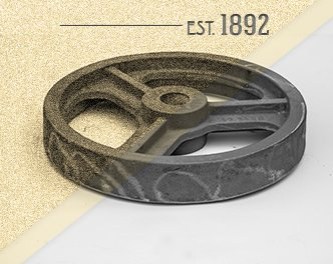Quality control
The production process control can be divided into several stages. The first stage involves the inspection of the molding mixture, into which the casting is formed. The next stage is the inspection of the liquid metal from which the casting is poured, and the final stage is the inspection of the casting itself (visual, dimensional, mechanical, metallographic).
- Foundry
Molding Mixture Control
The control is performed by a technology worker two to three times a week, or more often if necessary. After a sample is taken, the basic parameters of the bentonite molding mixture (compressibility, bonding strength, permeability, and moisture content) are determined in the sand laboratory. Based on the evaluation, the preparation of the bentonite molding mixture is adjusted. Once a month, a sample is sent to the bentonite binder supplier’s laboratory for a more detailed analysis. Additional parameters are determined here (bentonite content, residual carbon content, strength in the condensation zone, average grain size, etc.). Based on these results, the preparation of the bentonite molding mixture is corrected as necessary.
Liquid Metal Control
Liquid metal control is performed during its melting in an electric induction furnace and subsequently when it is poured into the mold. Before each tapping of the melt, a sample is taken for thermal analysis, where solidification curves generate the basic data for determining the quality of the metal (carbon content, silicon content, carbon equivalent, liquidus temperature) and a sample for spectral chemical analysis. The results are used for possible alloy and carbonizer corrections. For selected types (especially ductile iron castings), a sample for spectral analysis is taken during the pouring of the metal into the mold. The measured values are stored in a computer and serve as information for the customer or for investigating the causes of non-compliant products. Additionally, the temperature of the poured metal is monitored using an optical pyrometer.
Casting Inspection
Visual inspection is performed by an OTK (quality control) worker after cleaning the castings of residual molding mixture, except for piano and grand piano frames, whose inspection will be detailed further in the text.
If a defect that compromises the functionality of the casting is found, the casting is marked and rejected as non-compliant. If the defect does not affect the functionality of the casting, it is repaired by welding or filling. In cases of uncertainty about whether the defect affects the functionality of the casting, the OTK worker consults with the technologist or the production manager. Based on available documentation and technical delivery conditions (TDC), it is decided whether the casting can be repaired or rejected. In specific cases, consultation about the possibility of repair is conducted directly with the customer. The technologist, after consultation with the molding or foundry master, implements measures to prevent further defects.
Dimensional Control
is performed by an OTK worker, or in cooperation with a technologist, based on TDC agreed with the customer or during the production of new castings. The control is carried out using measuring instruments, supplied gauges, and measuring fixtures. If a deviation from the set tolerance is found, the casting is rejected, and a dimensional check of the pattern equipment is subsequently performed, on the basis of which an adjustment to the pattern equipment or technology is proposed.
Mechanical Testing
includes hardness tests and tensile tests. Hardness tests are carried out by the OTK worker at a specified location on the casting (in HB units). The tensile test, performed on a pre-cast standardized rod, generates the tensile strength value or elongation value after breaking, and is conducted by a metallurgy worker. Based on the results and customer requirements according to ČSN EN 1559-1 and 3, the metallurgy worker issues casting certificates.
If a non-compliance between the measured results and the relevant standards and TDC is found, the casting is rejected, and adjustments to the liquid metal recipe or the casting production technology are proposed.
Metallographic Testing
Metallographic testing is intended to control the material structure (shape, size, and distribution of graphite, pearlite, ferrite, and other potential components). It determines the qualitative characteristics of the metal substance. This testing is carried out externally by a technology worker based on the customer's request.
Inspection of Piano and Grand Piano Frames
Inspection of piano and grand piano frames is a two-stage process. The first visual and dimensional inspection (thickness check of the flat part of the casting) is performed by the blasting equipment operator, who marks a non-conforming area with chalk or, in the case of a deviation from the set tolerance, records the measured thickness value of the casting.
The second stage of the inspection is performed at the grinding station by the casting grinder. A visual inspection is conducted primarily for cracks or fractures, and a comprehensive dimensional inspection (checking flatness and deflection of selected parts of the castings) is performed using agreed measuring instruments and supplied measuring fixtures. If a casting is rejected due to an apparent defect, the grinder informs the OTK worker, who then records this information in the relevant form. If the grinder cannot clearly determine whether the defect can be repaired, they consult with the technologist, who, based on the provided documentation, TDC, and potential consultation with the customer, determines whether the casting will be repaired or rejected as non-compliant. Based on defects in the rejected castings, the technologist, after consulting with the molding or foundry master, implements corrective measures to prevent the occurrence of such defects.
The hardness of this group of castings is measured by the OTK worker on a pre-cast 8 mm plate. A tensile test is conducted approximately once a quarter. If significant deviations in monitored parameters are found, the interval for performing the tensile test may be shortened.
 Hand Molding
Hand Molding_0x265.jpg)
 Melting device
Melting device Agricultural Machines
Agricultural Machines Lifts
Lifts

